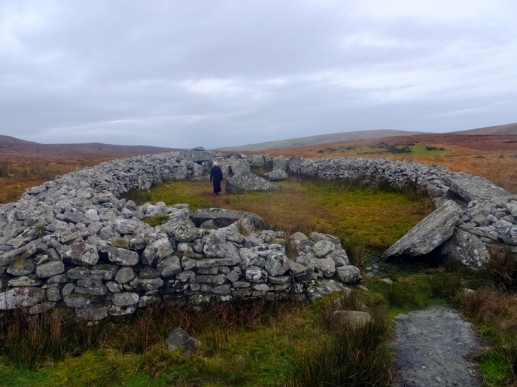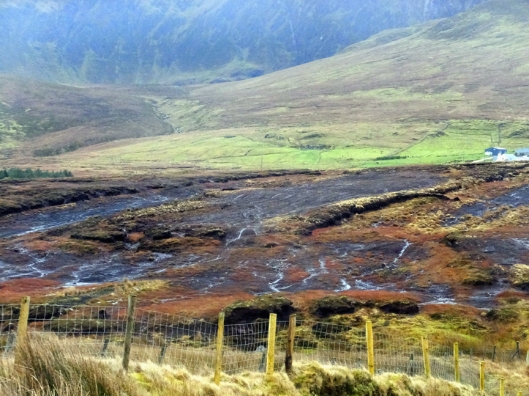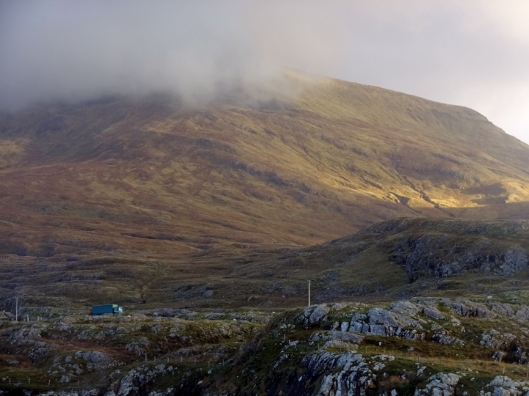Tags
Achill Island, Connemara, Cronin's Sheebeen, Cruit Island, Deserted Village, Donegal, Galway, Glencolumbkille, Grace O'Malley, Granuaile, Great Famine, Ireland, Slieve League, Sligo, Westport, Wild Atlantic Way
 The “Wild Atlantic Way” is a designated travel route that traces more than 1500 miles of Ireland’s rugged and beautiful west coast. From our base in Westport we managed to travel a good bit of it. All the places we visit in this post are situated along the Wild Atlantic Way.
The “Wild Atlantic Way” is a designated travel route that traces more than 1500 miles of Ireland’s rugged and beautiful west coast. From our base in Westport we managed to travel a good bit of it. All the places we visit in this post are situated along the Wild Atlantic Way.
Click on a photo to see it larger. It will open in a new tab. Close it or switch tabs to return.
Achill Island

Achill Island in County Mayo is the largest island off the coast of Ireland. It has a population of around 2,600, down from around 6,000 before the Great Hunger in the 1840s.

Many of the houses in these photos are vacation homes and holiday rentals. Tourism is now the major industry on the island.
There’s an interesting legend about Achill Island. In 1894, the Westport – Newport railway line was extended to Achill. The train fulfilled an ancient prophecy.
In the 17th century, 200 years before the invention of the railroad, Brian Rua O’ Cearbhain prophesied that “carts on iron wheels would carry bodies into Achill on their first and last journeys.”
That first train to Achill carried the bodies of victims of a boating accident on Clew Bay that killed 32 young people. They had been going to meet the boat that would take them to Scotland for potato picking.
The second part of the prophecy was fulfilled in 1937 when the last train to provide service to Achill carried home the bodies of 10 victims of a fire in a bothy in Kirkintilloch, Scotland. A “bothy” is a temporary accommodation for the potato pickers in Scotland.

Not sure exactly what this one warns against. Don’t go barefoot or you might fall off a cliff, perhaps?
Achill’s Deserted Village

At the base of Slievemore Mountain are the crumbling remains of about 80 homes. The place is called, simply, the Deserted Village.

In fields around the Deserted Village one can see undulating rows of ‘lazy beds’, in which potatoes were grown. You can see them in the green patch in the center-right of this photo.
The Great Famine struck in Achill as it did in the rest of Ireland. Some families emigrated, but most moved to the nearby village of Dooagh. Living beside the sea meant that fish and shellfish could be used for food.

The former residents and their descendants continued to use the site as a “booley” until the 1940s. During the summer, younger members of the family took the livestock to graze on the hillside and lived in the houses of the Deserted Village.
Grace O’Malley, The Pirate Queen
In the 1500s, this part of Ireland was the domain of Grace O’Malley, the Pirate Queen. O’Malley was the chieftain of the Ó Máille clan in the west of Ireland. She was well-educated, exceptionally competent, and a formidable warrior. Upon her father’s death she inherited his large shipping and trading business, which sometimes crossed the line into extortion and piracy. O’Malley is also known as Granuaile, an Aglicization of her name in Irish, “Grainne Ni Mhaille.”
While on Achill Island we paid a visit to Kildamhnait Castle, one of four castles that O’Malley is reputed to have owned.
Granuaile’s exploits are legendary. During a trip to Dublin in 1576, O’Malley attempted to pay a courtesy visit to Lord Howth. She was informed that the family was at dinner. The castle gates were closed against her. In retaliation for this insult, she abducted Howth’s grandson and heir. He was eventually released when a promise was given to keep the gates open to unexpected visitors and to set an extra place at every meal.
When members of the MacMahon clan killed Granuaile’s lover, Hugh de Lacy, whom she had rescued from a shipwreck, she and her men killed those responsible for de Lacy’s death. Not satisfied with her revenge, she attacked the MacMahon’s Doona Castle, taking the castle for herself.
In 1593 her sons and her half-brother were taken captive by the English governor of Connacht. O’Malley sailed to England to petition for their release. She formally presented her request to Elizabeth I. Their discussion was carried out in Latin, as O’Malley spoke no English and Elizabeth spoke no Irish. After much talk, the two women came to an agreement about how O’Malley and her clan would be treated in western Ireland. O’Malley later realized that the agreement with Elizabeth had been useless, and went back to supporting Irish insurgents.

This bronze statue of Granuaile is in the O’Malley exhibit in the public library in Louisburgh, County Mayo.
Grace O’Malley most likely died in 1603, the same year as Queen Elizabeth.
The big Hollywood movie of her life is yet to be made.
Donegal
Both of us very much wanted to see Donegal in Ireland’s far northwest. Since it was a bit too far away for a day trip, we booked a room for two nights in Glencolumbkille, County Donegal, and set out northward on the Wild Atlantic Way.

On the way to Donegal we detoured onto a coastal boreen near Ballyshannon and glimpsed this castle high on a distant cliff.
Glencolumbkille
Glencolumbkille is a tiny village on Donegal’s rocky coast. We chose it because we found cheap accommodations there, and it was more-or-less in the vicinity of some places we wanted to visit.

The Aras Ghleann Cholm Cille is a hostel with private rooms available. It is inexpensive, rustic, cozy, and comfortable. This time of year there were only a few guests, with whom we enjoyed sharing time in the large common kitchen/dining room. (Photo courtesy Hostel World.)

From Glencolumbkille, you can just see the old Martello observation tower on the plateau across the water. These towers can be found all along Ireland’s coasts. They were built by the British to watch out for the French during the Napoleonic Wars.

Not far from the hostel this site was marked by a sign saying it was a “Court Cairn,” a type of burial site.

“Passage tombs” mark the burial sites. Many passage tombs are aligned so that sunlight enters the tomb at particular times of the year, like the summer or winter solstice.
Cruit Island
From Glencolumbkille, we drove north on the Wild Atlantic Way so that Sarah could revisit Cruit (pronounced “Kritch”) Island, a place she had stayed with a good friend years ago.

The small island is between Rosses Bay and the Atlantic Ocean. It is sprinkled with vacation homes, all with spectacular views.

Here Sarah stands in front of the thatched-roofed cottage where she and her friend Margaret stayed in 1996.
Slieve League

The massive coastal cliff formations called Slieve League were another sight we did not want to miss in Donegal.

But for a while we thought we wouldn’t get to Slieve League. We found the narrow road blocked by a crippled backhoe. The friendly crew seemed quite amused by my picture-taking.
Driving Through Donegal

We passed peat bogs where harvesting was evident. These beds of ancient organic matter have been providing fuel in Ireland for thousands of years.
Sligo
On the way back to Westport we managed to work in a short stop in Sligo, Tallahassee’s sister city in Ireland.
Connemara
Built in the 1800s, Connemara’s 40,000 square-foot Kylemore Abbey has more than 70 rooms. The estate was in private hands until the owner was forced to sell it due to gambling debts. In 1920, the Benedictine Nuns operated it as a school for Catholic girls until 2010.

While driving the Wild Atlantic Way in Connemara, we were frequently reminded of one traffic law a driver must obey in rural Ireland: Sheep always have the right of way!
Galway

At the eastern end of Connemarra is the delightful city of Galway. We drove there for a day-into-night trip.
Christmas Eve in Westport

Our generous and friendly Westport hosts invited us to attend Midnight Mass with them on Christmas Eve. Pictured here after mass are (L-R) Mairead, son Simon, Brian, and of course Sarah.

“Midnight Mass” was over by 10 pm. After that, we accompanied our hosts to Cronin’s Sheebeen, where we joined entire families of other locals for their traditional Christmas Eve celebration.
We were warmly welcomed into the lives of our hosts in Westport. Their son, Simon, was a frequent visitor in our cottage. In addition to joining them in The Sheebeen, we were invited to dinner at their table, and to go on walks and hill climbs with the family. This made our stay in Westport very special.
After Westport, we drove across Ireland from the Atlantic in the West to the Irish Sea in the east. We were heading for four weeks in Dublin, the last stop on our six-month European adventure. There we found the quintessential modern Irish city marked with living evidence of the nation’s painful birth, and took day trips to explore more ancient Irish history in Glendalough and Tara. We hope you will join us for the last leg of our trip.





























Thanks for sharing these wonderful pictures. I’m hoping you all write a book that would tell the reader how to plan an adventure like yours’!
LikeLike
Awesome! Wish that Joe and I could have extended our visit with you in Kinsale and traveled with you to Westport and surrounding areas!
LikeLike
Love the shots of the sea pounding the rugged coastline!
LikeLike
Me too Calvin. Those are among my favorites too. Thanks! C
LikeLike